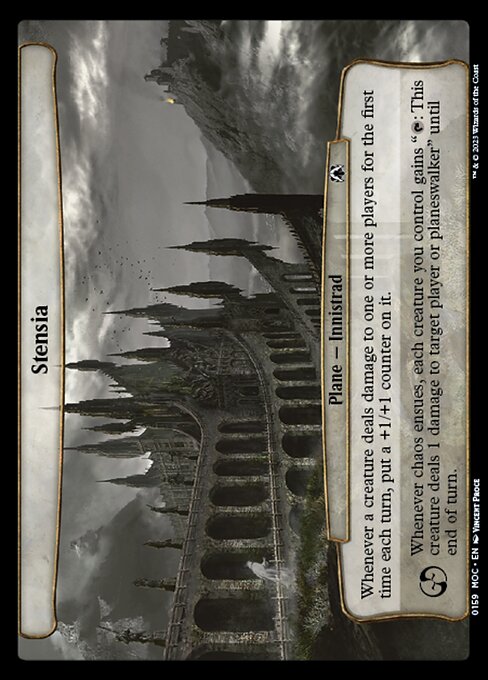
Image courtesy of Scryfall.com
Stensia on the Multiverse Stage
When we’re talking about cross‑plane events in Magic: The Gathering, certain cards feel tailor-made to the chaos that unfolds when disparate worlds collide. Stensia—a Planes card from the March of the Machine Commander set—feels like a quiet conductor in the orchestra of multiverse spectacle. Hailing from Innistrad, a plane perpetually caught between gothic horror and heroic resilience, Stensia’s presence in the multiverse narrative signals how a single location can exert influence across events that ripple through multiple formats and storylines. 🧙♂️🔥
Stensia’s dual triggers read like a microcosm of Innistrad’s volatility: growth through combat, and a controlled spark of chaos that pushes your creatures to strike harder, faster, and with a bit more reckless flair. ⚔️
Two engines of difference: growth and chaos
First, the card’s core ability rewards aggression in a very MTG way: whenever a creature deals damage to one or more players for the first time each turn, that creature gets a +1/+1 counter. In practice, this creates a compelling tempo engine. You don’t need to wait for a big payoff; you simply need to start dealing a early dose of damage to players, and your board begins to hum with every subsequent strike. It’s a mechanic that encourages pressure and forces your opponents to respond not just to the board, but to the pace of every turn. In multiverse-events terms, this mirrors how a localized surge can cascade into a larger strategic shift—small, repeated wins stacking into an overwhelming momentum across the battlefield. 🧩💥
Secondly, the chaos mechanic unlocks one of Innistrad’s favorite vibes: a dramatic swing when chaos erupts. The card says that whenever chaos ensues, each creature you control gains “{T}: This creature deals 1 damage to target player or planeswalker” until end of turn. It’s essentially a temporary, all-hands-on-deck damage amplifier. Thematically, it echoes Innistrad’s Nightmares and unquiet nights—moments when a city instinctively seizes what it has and turns it into a sudden, chaotic offensive. In multiverse events, this can act as a bridge between a local skirmish and a broader clash, a moment where a single turn’s chaos ripples into the larger story arc. And yes, it feels delightfully cheeky in EDH circles where you can push a big win with a flurry of directed damage. 🎯⚡
Strategic angles for cross‑plane play
- Push early, leverage growth: With Stensia, leaders of aggressive boards can accelerate their clock. Your first couple of combat steps might set the stage for a cascade of +1/+1 counters, turning small creatures into threat multipliers that are hard to answer in a single turn. In multiverse events, this mirrors how a regional spark can become a planet-wide spark if left unchecked. 🔥
- Pair with evasion or recital effects: Creatures that reliably hit players—flying, menace, or evasion—amplify the first-damage trigger. Each hit becomes not just a strike in the moment, but a permanent growth in the following turns, which can escalate into a decisive leadership swing during chaotic crossovers. 🗡️
- Chaos as a tactical reset: When you trigger chaos, the temporary “untethered” damage ability can shift the balance, allowing you to punch through a protector line or pressure a planeswalker that’s been untouchable. It’s a dramatic gambit that suits the tempo of events where the narrative and the game demand a moment of reckless brilliance. 💎
- Commander synergy: In a five-player or lone-commander game, Stensia shines as a centerpiece that rewards attack-oriented decks. The card’s Planeswalker-tinged flavor blends well with a variety of Innistrad-themed and multiverse-crossing strategies—where old loyalties, new threats, and chaotic turns converge. 🧙♂️
Flavor, lore, and the art of crossing planes
Innistrad’s Stensia is a region steeped in aristocratic vampires and ancient pacts, a place where power is both cultivated and contested with gothic elegance. The card’s lore-friendly plane designation—Innistrad—anchors it in a story world where fear, faith, and ferocity intersect. The two triggers evoke a narrative cadence: growth emerges when a creature dares to strike, and chaos erupts when the city’s torches flare, transforming all your creatures into temporary weapons capable of reaching for high-stakes targets. It’s a perfect microcosm of multiverse events: small, regionally grounded phenomena that nonetheless echo across the broader web of planes and plotlines. 🧛♀️🌗
The artwork, by Vincent Proce, leans into the planar-empire aesthetic—grand, slightly restrained, and with a sense that something ancient hums just beneath the surface. In the context of multiverse events, Stensia is a reminder that not every battle needs a grand spell; sometimes, it’s the steady march of counters and the sudden spark of chaos that rewrite the arc of a narrative. And let’s be honest: a card that quietly pushes your board toward exponential growth while offering a dramatic, one-turn chaos hammer is the kind of design that makes you grin while you draw it. 🎨⚔️
Design notes and collectibility context
As a common nonfoil with an oversized presentation in the MOC Commander set, Stensia leans into a slightly more accessible strategic plane for players exploring the Commander format. Its zero mana cost and planar type emphasize flexibility—an invite to experiment with cross-plane synergies without being locked into a single color identity. The card’s low price on market data reflects its more casual niche, but in the right deck, it delivers memorable moments that feel like a nod to the multiverse’s wild, interconnected nature. Collectors appreciate the lore tie-in to Innistrad’s storied past, along with the art that captures a sense of ancient puissance and nocturnal drama. 🧩💎
Neoprene Mouse Pad Round or Rectangular, One-Sided PrintMore from our network
- https://crypto-acolytes.xyz/blog/post/what-is-concentrated-liquidity-in-defi/
- https://blog.digital-vault.xyz/blog/post/how-templating-affects-understanding-of-agatha-the-vile-cauldron/
- https://transparent-paper.shop/blog/post/how-digital-paper-elevates-social-media-templates/
- https://transparent-paper.shop/blog/post/distant-hot-giant-reveals-ancient-metal-poor-clues/
- https://blog.digital-vault.xyz/blog/post/what-makes-surge-of-thoughtwefts-artwork-iconic-in-mtg/